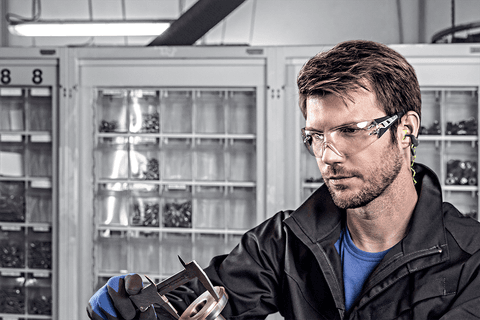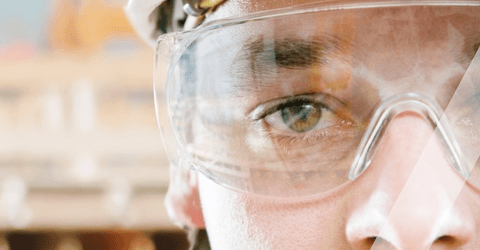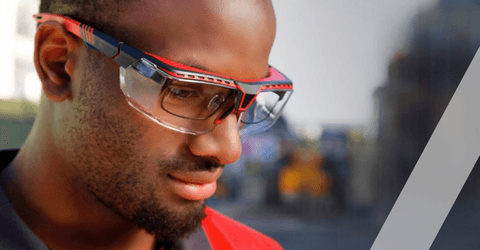
Whether it’s dust, debris or chemicals, your eyes can be exposed to countless hazards in the workplace.
Eye protection comes in all shapes and sizes from safety goggles to eye protection over glasses, eye shields and dust goggles. These various forms of eye protection are designed to safeguard against different hazards, making them a critical component of personal protective equipment (PPE).
Tower Supplies offers a comprehensive range of eye protection solutions, including safety glasses, safety goggles, and face shield protection. Safety glasses are ideal for environments like woodwork, where flying wood chips and debris pose a risk to the eyes. Safety goggles are crucial in laboratory settings, protecting against chemical splashes and airborne contaminants. Face shield protection is vital in construction, where larger debris and projectiles can be encountered. Additionally, in cold weather conditions, when the risk of eye injury due to harsh elements is elevated, protection of this valuable organ becomes indispensable.
Tower's diverse selection of eye protection ensures that workers are equipped to mitigate risks and stay safe across various industrial environments.
Often separate lenses in a metal/plastic frame, similar in appearance to prescription glasses with a single lens/frame moulding and side shields.
For those who require vision correction, these eye protection glasses can incorporate corrective lenses, and over-glasses fit over prescription glasses.
This type of protective eyewear is highly versatile for a range of applications including protection from chemicals, intense light, debris and many other possible eye irritants. Their adaptability ensures safety glasses can safeguard workers across diverse work settings whether that is construction, laboratories or industrial settings.
Safety goggles are secured with an elasticated strap that runs around the back of the head, They often have an inner seal to close the gap between the lens and face, providing protection from all angles, as the whole rim is in contact with the face.
PPE goggles are designed for comprehensive eye protection. They are essential in laboratories to shield against chemical splashes and toxic fumes. In manufacturing plants, they shield from metal shards and intense machining processes. On construction sites, they protect from flying debris and dust and for healthcare professionals they provide a barrier against potentially harmful fluids and infections.
The complete rim-to-face contact ensures that no matter the work environment, safety goggles provide all-around eye protection.
A face shield is a form of PPE that aims to protect the entire face, or part of it, from flying debris, objects, and chemical splashes. Face shields are a large lens with a frame and adjustable head harness or are mounted on a helmet.
This crucial piece of protective eyewear provides extensive coverage from a wide range of hazards.
As well as a range of industries such as industrial environments, construction, healthcare, laboratory work, or food preparation, this PPE eye protection shields workers from tangible and intangible threats. Face shields provide a critical barrier from flying debris, fragments and dust as well as intangible threats such as chemical fumes, UV rays and airborne particles.
Their versatility makes them an essential component of PPE for a wide range of industries and professions.

There are many working environments that will require eye protection. Here are some of the most common scenarios:
The biggest risk to eyes when working with wood is dust. Sanding and grinding produce a very fine spray of wood particles. As a minimum, this would cause eye irritation, if not worse problems and damage. Full safety goggles are again the most suitable form of eye protection.
The main risk to eyes in a laboratory is chemicals. If a hazardous or corrosive substance has been spilt or splashed and gets in or near the eye, it could result in irreparable damage. The most suitable eye protection is full safety goggles with a protective seal and should be always worn.
There are multiple risks to eyes on a construction site, including smoke, dust, light exposure, and even electrical discharge. The most suitable eye protection that someone needs on a construction site will depend on the exact environment, but full safety goggles may well be needed.
Keeping vision at its best as well as keeping the eyes protected is an important consideration when choosing eye protection. As goggles and glasses are more likely to suffer from misting and fogging in cold temperatures, it’s important to choose a product with an anti-mist lens coating.
As with other forms of PPE, having the right eye protection is about more than just choosing the product. Before putting them on, make sure you thoroughly inspect your safety goggles or safety glasses. Look for dents, scratches, and cracks that could reduce the item’s protective capabilities.
As safety eyewear is often exposed for extended periods to harsh environments, flying debris, and other hazards, they will suffer from wear and tear and even decay over time. If you are ever unsure whether your eye protection is still suitable, replace the item promptly.
Your eyesight should never be lessened just so you can wear safety glasses, it would be equally dangerous. Prescription safety glasses can be expensive, so you should always try to wear your safety glasses over your normal glasses, which will protect both your eyes and the glasses’ lenses.
If you plan to wear safety glasses over your prescription ones, then make sure they are comfortable and secure. Do not compromise when choosing safety eyewear, and if possible, choose safety glasses that are specifically designed to fit comfortably over prescription eyewear.

Learn more about the main EN standards relating to the manufacturing and use of PPE eye protection by clicking on the link below...
From streamlined safety spectacles to large safety goggles designed to be worn with a face shield or respirator mask, we supply a range of eye protection PPE. This includes adjustable eye protection to suit a wide variety of face shapes and safety spectacles in a face “hugging” style to reduce slip risk.
We’re PPE and safety experts and can give you the best advice and guidance on which type of safety glasses, safety goggles, or face shields to use. We help you work safer and be better, so call us today on 01202 718000 or fill out our contact form below and we will be in touch.